Who Is Fabián Ruiz?
Born in Los Palacios y Villafranca, Fabian Ruiz is a graduate of Betis Deportivo Balompié, who made his first-team debut at the age of 19.
After making 50 appearances in La Liga, he signed for SSC Napoli with a 30m Euro transfer fee, quickly becoming one of Carlo Ancelotti‘s most important squad members.
The 24-year-old Spanish international Ruiz has become one of the hottest midfielders in Europe.
Despite the change of manager and reinforcement of the Gli Azzurri in winter, Ruiz has remained a regular starter and handed convincing performances against strong opponents like Barcelona and Inter.
This tactical analysis is a scout report that will give you a detailed analysis of Ruiz under Carlo Ancelotti’s tactics, and explain why he is a wanted man of several big clubs across Europe.
Fabián Ruiz Style OF Play – Touches on the ball
Just like many other famous Spanish players, Fabián Ruiz’s style of play has good techniques to receive the ball.
One of his best traits is his touches.
Though the 24-year-old is a left-footed player, he is also good at using his right foot to receive the ball.
The pattern of using the right foot to place the ball in front of his left is commonly seen in matches.
This allows the Spaniard to play his pass with a strong foot afterwards.
Therefore, the next pass would be more guided and controllable in terms of power and direction.
Ruiz’s right-foot touch also helps him to open his body shape when receiving lateral passes, hence creating a better angle for scanning his surroundings.
This allows Ruiz to quickly change his direction, which is especially useful when the approaching player loses his balance and brings the ball out of pressure.
An example was taken as follows: Ruiz nicely places the ball in front of his left foot and opens his body.
The pass to the vertical option is easily played.
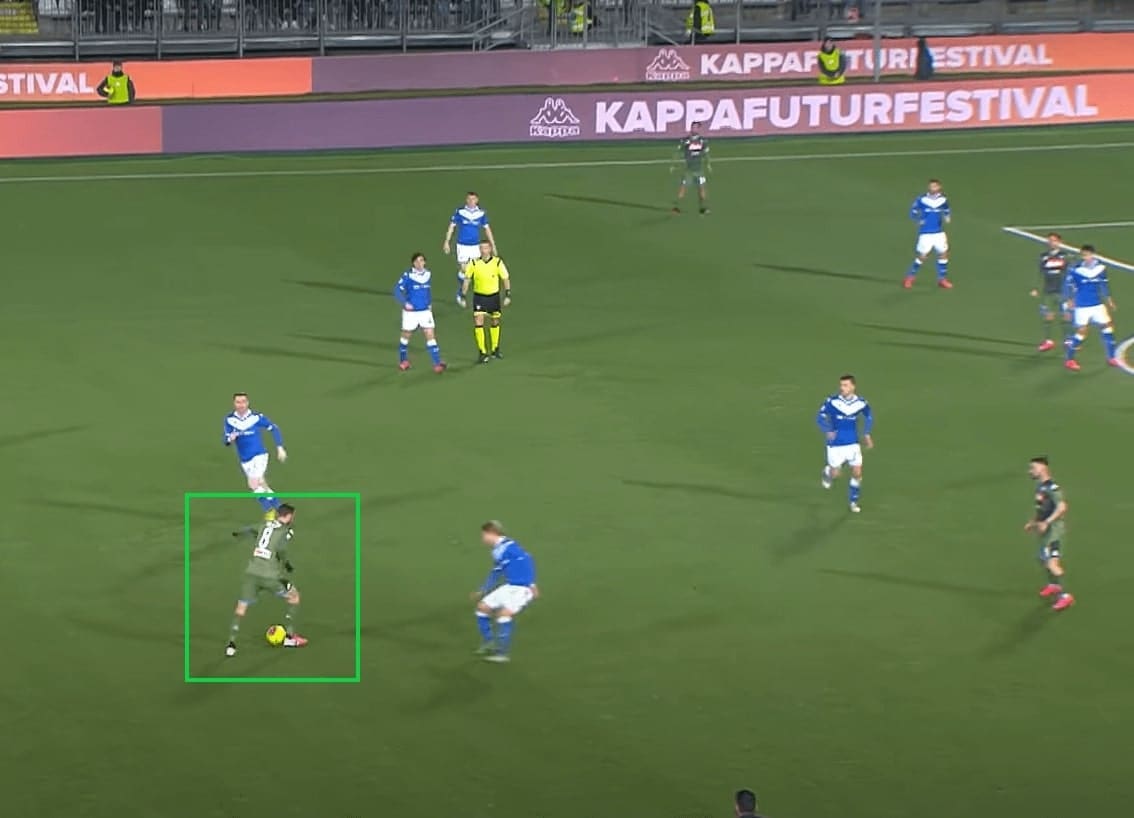
Fabián Ruiz is a 1.89-meter-tall midfielder who needs to protect the ball without losing his balance when facing pressure.
This was done by the touch as explained.
When the ball went to his left foot, Ruiz used his right foot and his body to separate the opponent and the ball.
The challenger could either make a foul or let him pass.
The following image is an example.
When Ruiz was playing the pass under pressure, he used the right foot as the fulcrum to resist the press, leaning his body backwards.
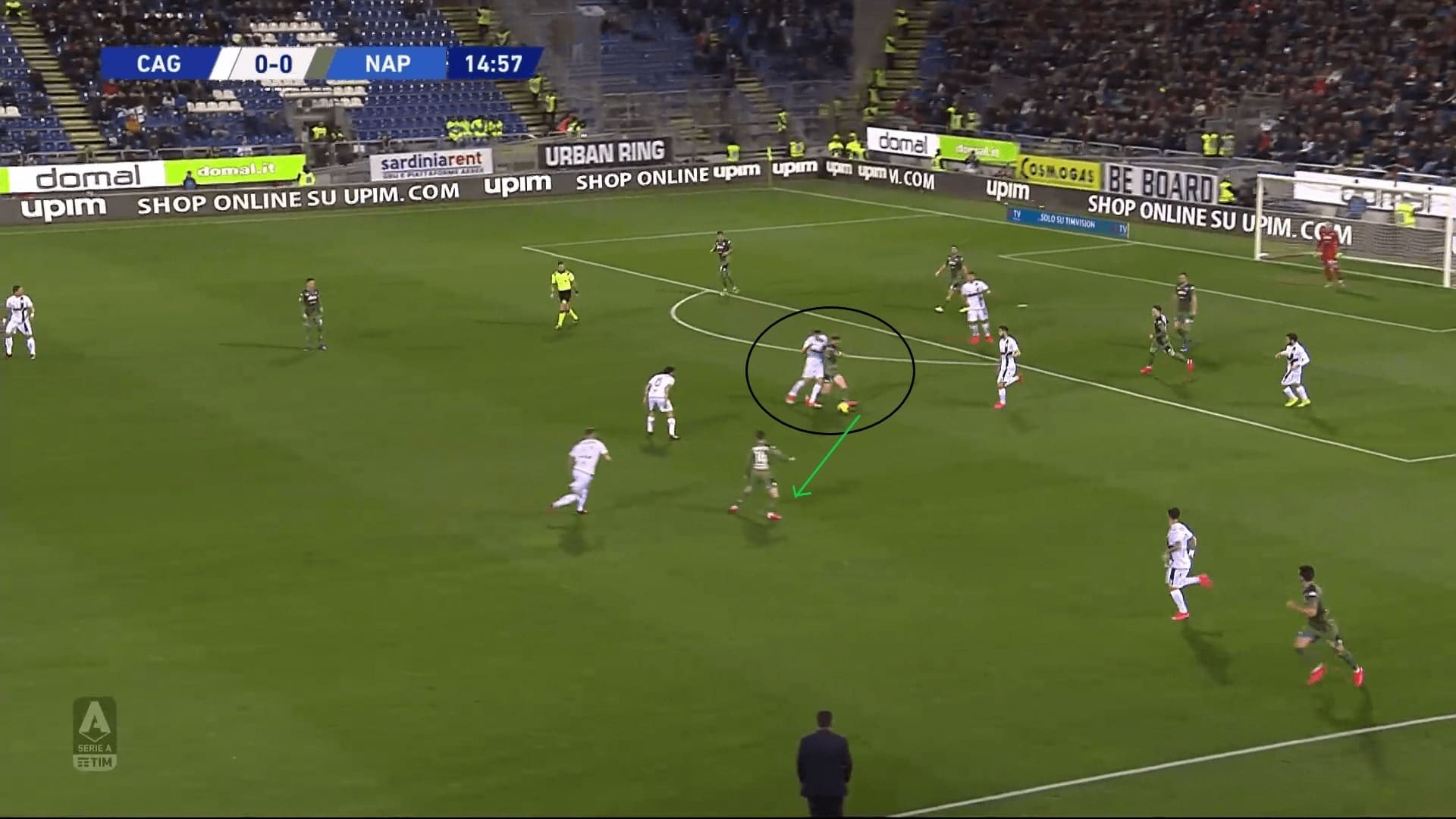
As mentioned, the good first touch of Ruiz helps him to change directions according to the situations.
This is the reason that he noted promising figures in terms of dribble success rate (72.43%, ranked 6th among the Serie A midfielders) and progressive run per 90 minutes (2.78, ranked 7th among the Serie midfielders).
The quick changes of direction help Ruiz not only get rid of his opponent but also disguising them when playing a pass.
In the following image, Ruiz’s body orientation obviously hinted at a pass to the left side of the pitch.
However, with a quick change of direction to his right foot, Ruiz quickly adjusted his body shape to another side, playing the pass to Torino’s weak side.
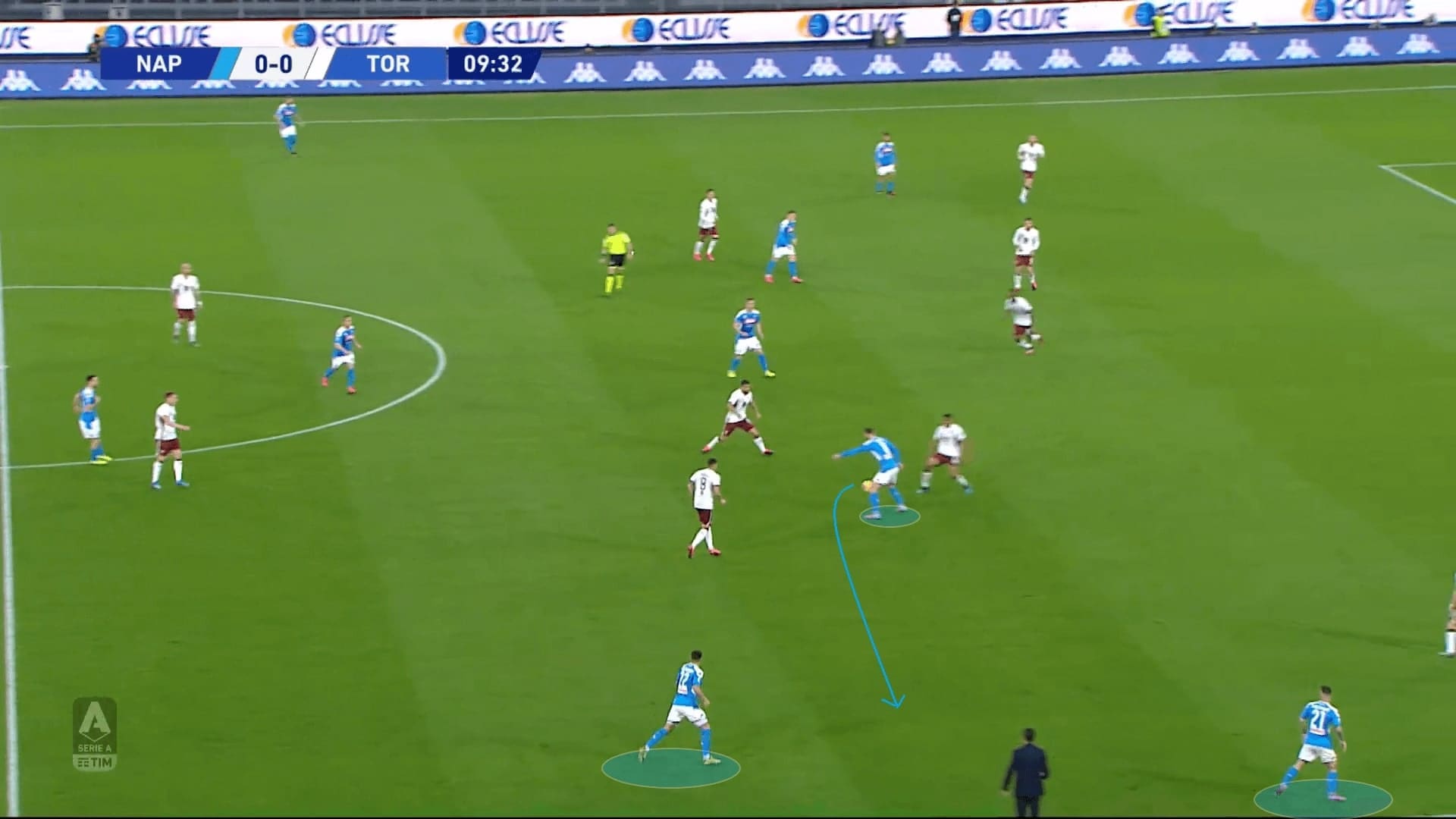
Nevertheless, this habit also had a disadvantage.
Since the ball was closely positioned in front of his foot, it was difficult to generate power quickly.
Therefore, passes from Ruiz were light in power on most occasions.
Fabián Ruiz Passing & vision
Ruiz is a good passer.
We summarized the passing statistics of the Spaniard and the best midfielders in Serie A who played more than 900 minutes and compared their statistics.
Since Gennaro Gattuso has implemented a possession-based playing style in the team, Ruiz has become one of the best forward passers in Italy.
He stands out in the following scatter diagram, which lists the number of forward passes and success rate of different midfielders.
Ruiz’s 20.65 forward passes per game with an accuracy of 87.18% were better than most players in the league, comparable to Miralem Pjanić’s 21.41 (86.2%).
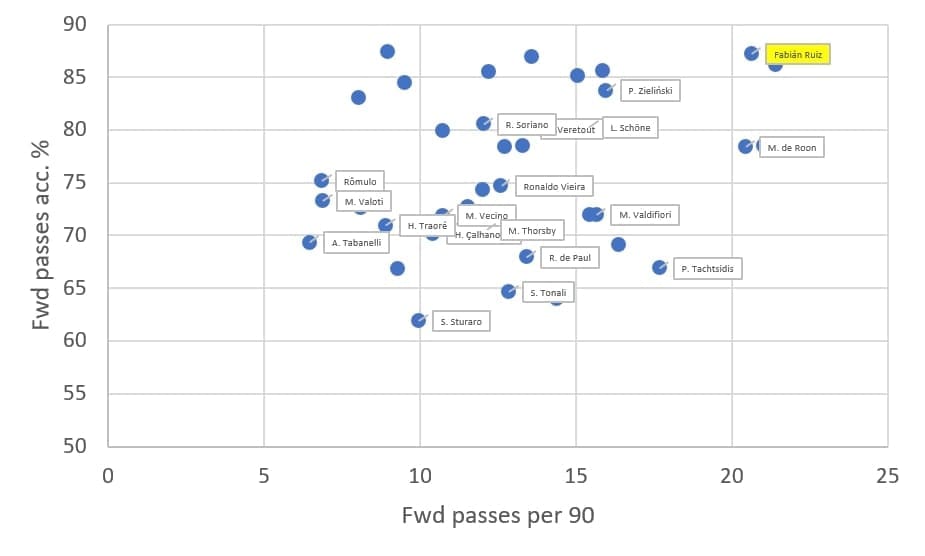
So, where does Ruiz stand in Europe?
In this scatter diagram, we chose two other criteria to measure the Spaniard’s passing ability: progressive passes per 90 and final third passes per 90.
Ruiz still obtained impressive figures and placed himself around some of the best midfielders in Europe, such as Kevin De Bruyne, Joshua Kimmich, and Marco Verratti.
Ruiz’s 9.66 progressive passes per 90 ranked in the
upper quartile in terms of the diagram, while his 12.13 final third passes were even more than familiar names like Frenkie De Jong and Arthur of Barcelona (and also the highest when comparedwith Serie A midfielders).
We believe he obtained these statistics as he was given the leading role in Napoli’s build-up plays, which was a section that we were going to explain.
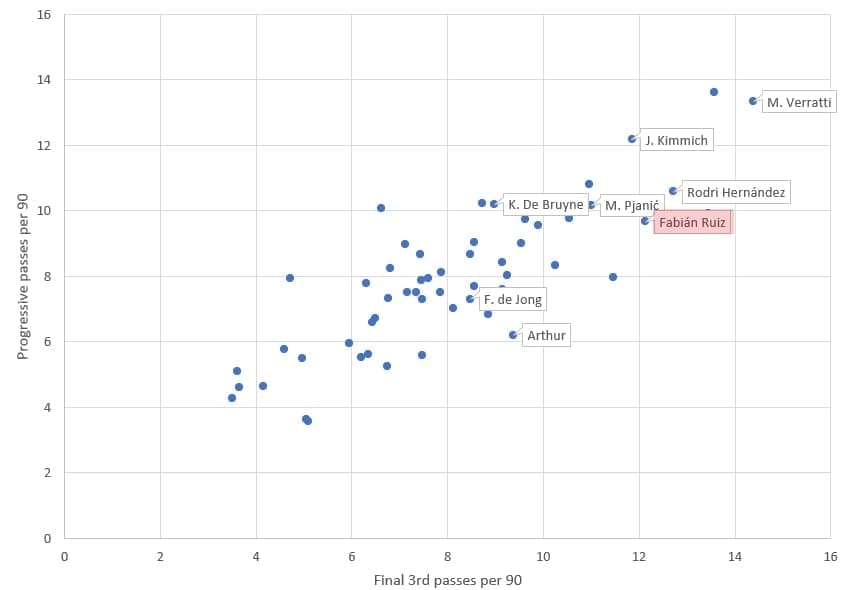
For a possession-based team that liked to play out from the back, a pass that breaks multiple layers of defensive lines and surpasses players was always a favourable and good one.
This would help his team to access a higher area of the pitch.
Ruiz mastered short-medium passes (65.82 per 90 minutes, 92.69% success rate, top of the Serie A), and this strength was utilized by Gattuso’s tactics.
When positioning himself in a deeper area, Ruiz frees himself from the markers to place his body facing the goal.
He has the vision to recognize gaps between players and break the lines with a good pass.
In the image below, he picks Lorenzo Insigne with a pass that surpasses six Torino players.
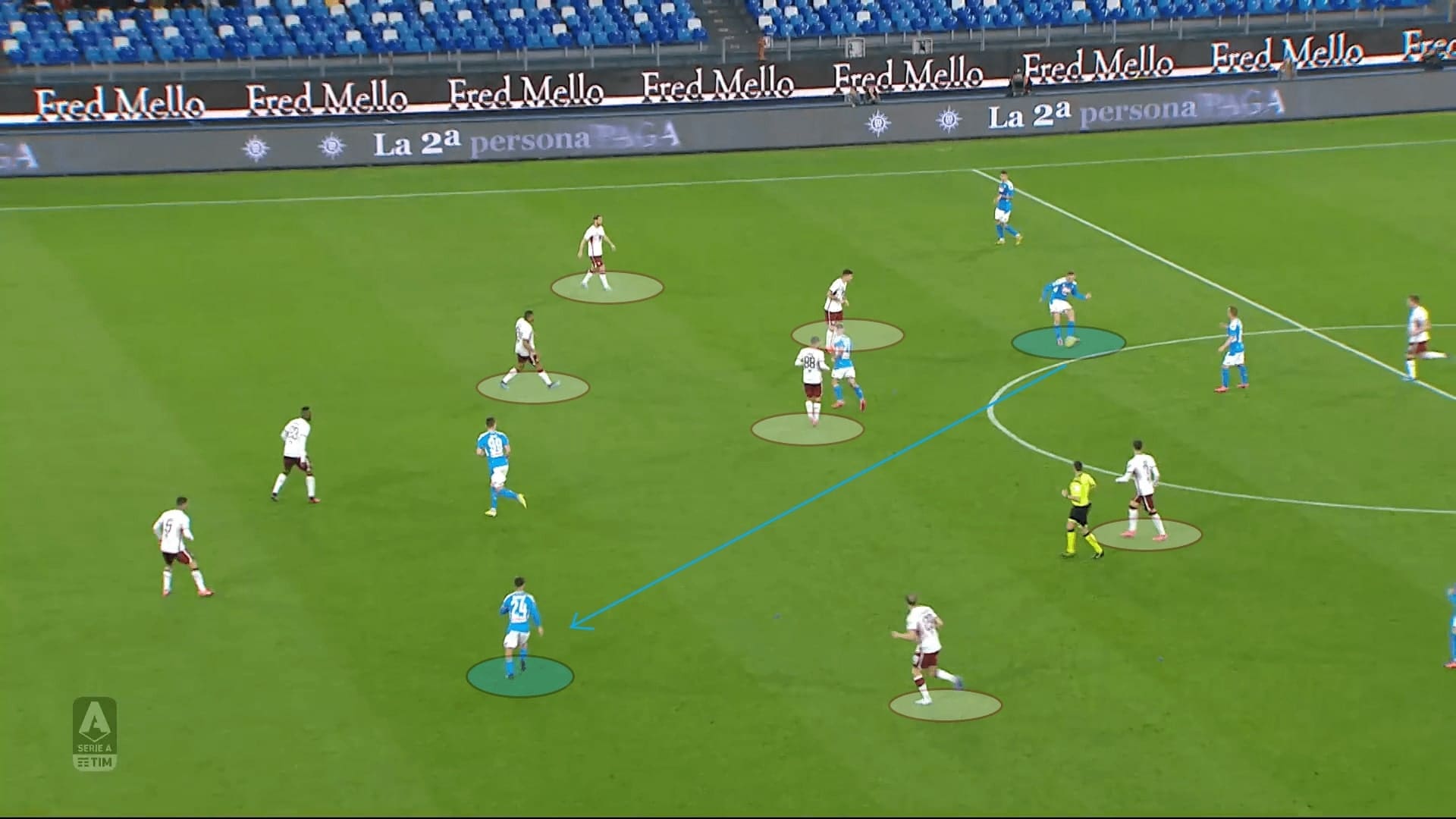
Since Ruiz constantly observes the pitch by looking at two directions, he receives more visual information than the others.
Except for those direct and vertical passes, the 24-year-old can also play a curved pass, which is always difficult to track.
These types of passes could be used during a switch of plays to break a block and release the wingers at the flanks.
Combined with his ability to perceive the information, Ruiz is able to make first-time passes if needed.
For example, he seized the moment, playing a curved pass to José Callejón before the No.7 was offside.

The passing ability of Ruiz is helpful to break a high line during the offensive transitions.
When the opposition pushes high up, they leave spaces between the last man and the keeper.
This gives the opportunities for the counter-attacking players to run behind and Ruiz’s penetrating passes can be utilized.
As mentioned, he is good at identifying gaps between players and playing a penetrating pass, just as he did in this image.
Despite an opponent being in front of Ruiz, the Spaniard still picks the optimal option with a comfortable ground pass.
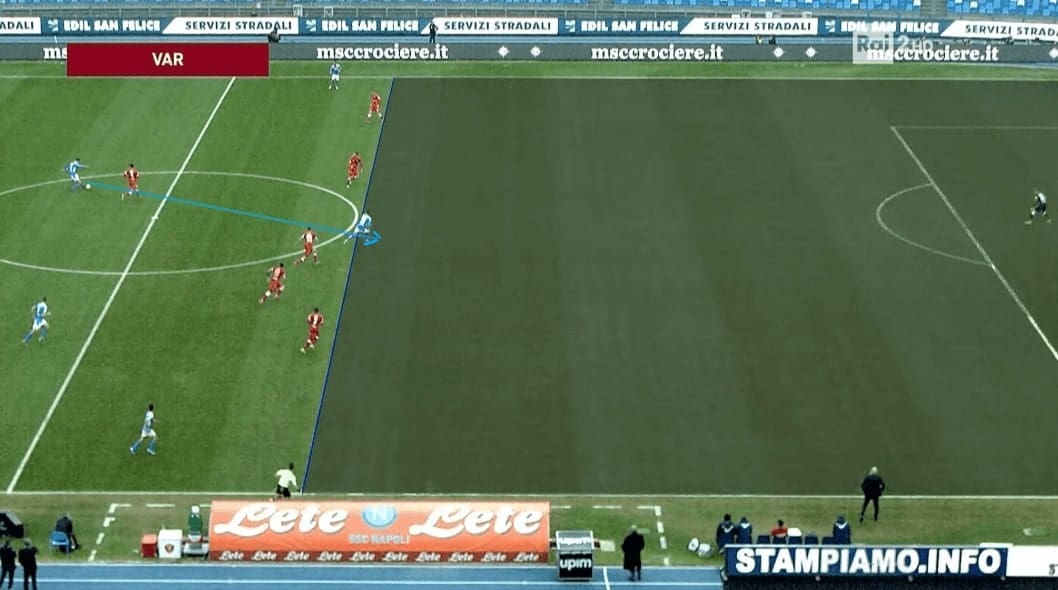
The last example we are showing is a mix of body feint and sound decision-making.
A body feint is helpful to disguise his opponents, no matter if it is in the build-up phase or in the final 3rd.
When spaces are available in front of the box, Ruiz likes to try a curling effort to find the top-left corner.
He has scored goals against Brescia and Inter with these cut-in shots.
Before shooting past Daniele Padelli’s net, the whole attacking movement was initiated by a clever pass from Ruiz.
The Spaniard positioned himself at the half-spaces initially, with an overlapping option at the flank.
Despite the hints of the body orientations, Ruiz did not pick the easy option, instead, played between the Inter players to find Allan.
He also recognized spaces in front of the box, received the Brazilian’s return ball, and curled the ball in.
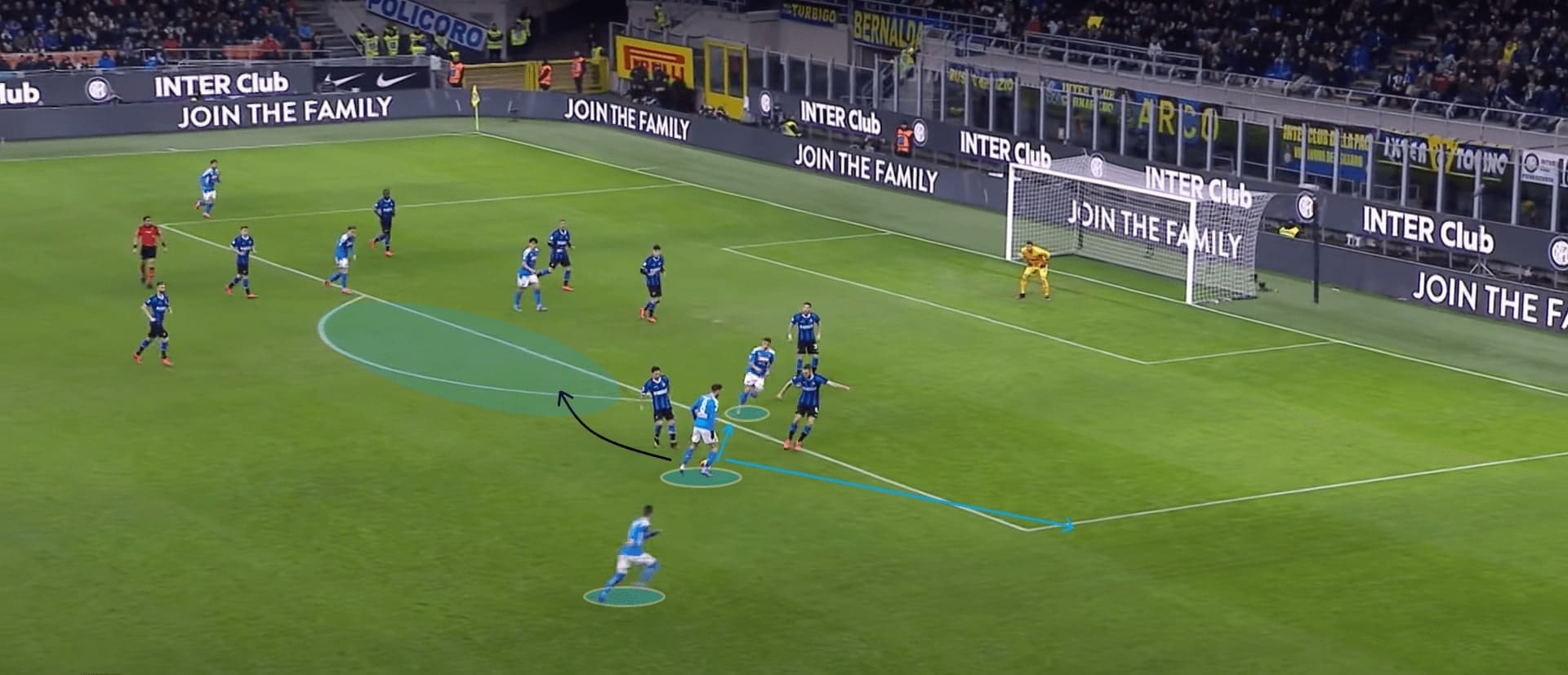
Tactical role at Gattuso’s Napoli
With his good positioning sense and understanding of the game, Ruiz plays an important tactical role in the positional plays at Gattuso’s Napoli.
He played as the sole pivot in Gattuso’s early spells and later moved to a more advanced position.
When playing as the defensive midfielder, Ruiz’s positioning is important to help his team circulate the ball, escaping from the ball side.
It is unlikely to see Ruiz rushing into the penalty area; instead, he always chooses a good time to make himself available at the half-spaces.
Moreover, Ruiz’s good passing allowed his team to quickly switch the offensive focus to the opponent’s weak side, creating an overload.
Take the below image as an example.
Napoli’s left flank was filled by Lazio players. The opposition midfield trio moved to this side to cover the half-spaces, and two strikers were waiting for a counter-attack opportunity.
All Ruiz had to do was appear at the right time to receive Insigne’s pass and quickly spread the ball to the opposite side.
On the right flank, the Lazio left-back was overloaded by Elseid Hysaj and Callejón.
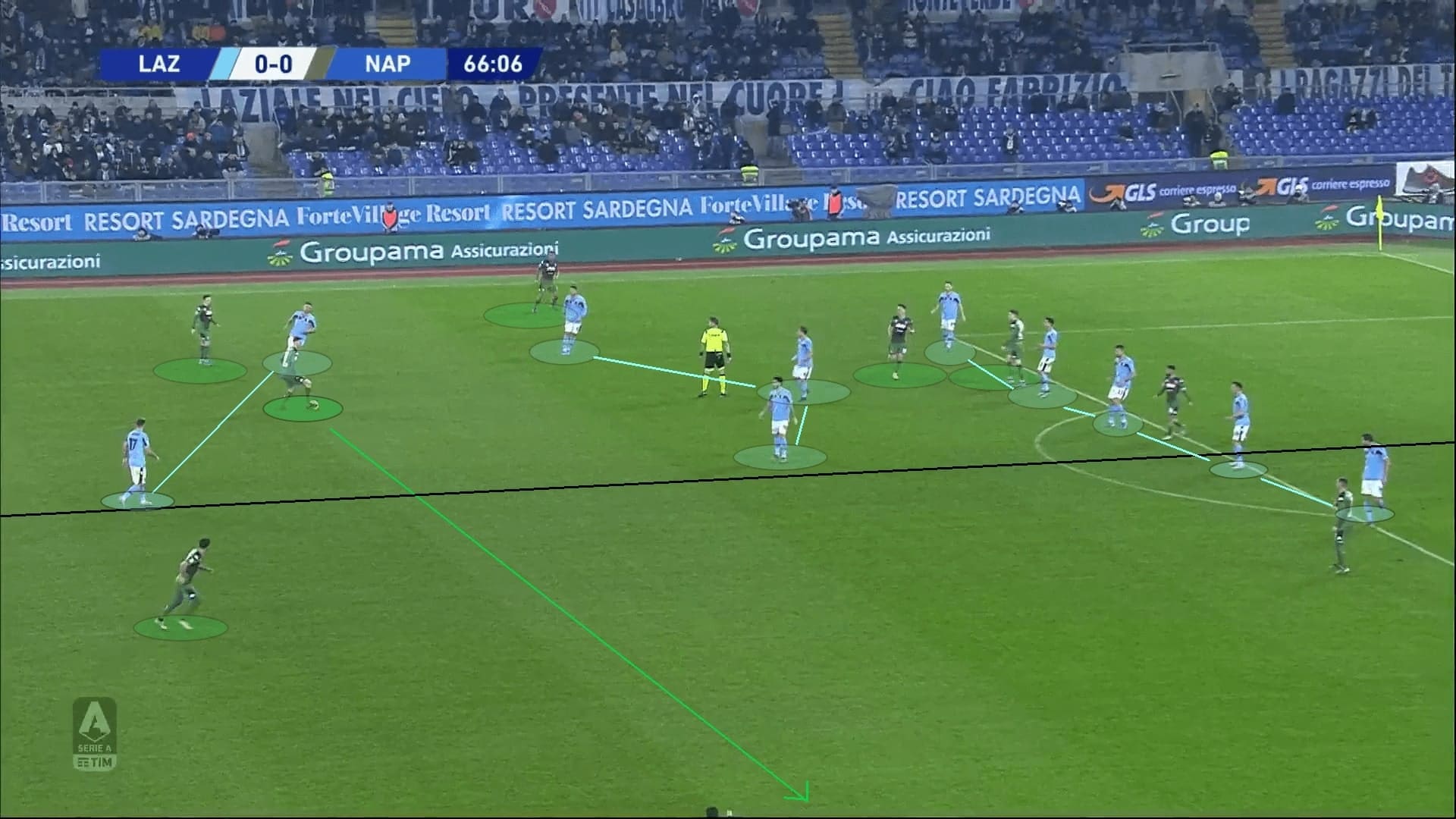
As the Napoli advanced midfielder, Ruiz has the mission to progress the ball.
This is important as the offensive abilities of Diego Demme and Stanislav Lobotka were limited.
When the centre-backs were under pressure.
Clearly, the Gli Azzurri needed a progressing option to play out from the back.
Therefore, Ruiz was often moved to the flanks to receive the ball from the full-backs.
The pressure towards the full-backs triggered his broad movement, where he would have the ball behind the pressure.
In our May magazine edition, we explained how this vast overload worked.
To briefly conclude, Ruiz was an essential player in the build-up: under Gattuso, he received 52.72 passes per game, more than his 46.38 under Ancelotti this season.
The image below is an example.
Demme was controlled by a marker, and the ball was moved to the right-back.
Cagliari already committed the midfielder to approach the ball, this gave Ruiz the chance to get behind the pressure and receive the ball from Giovanni Di Lorenzo.
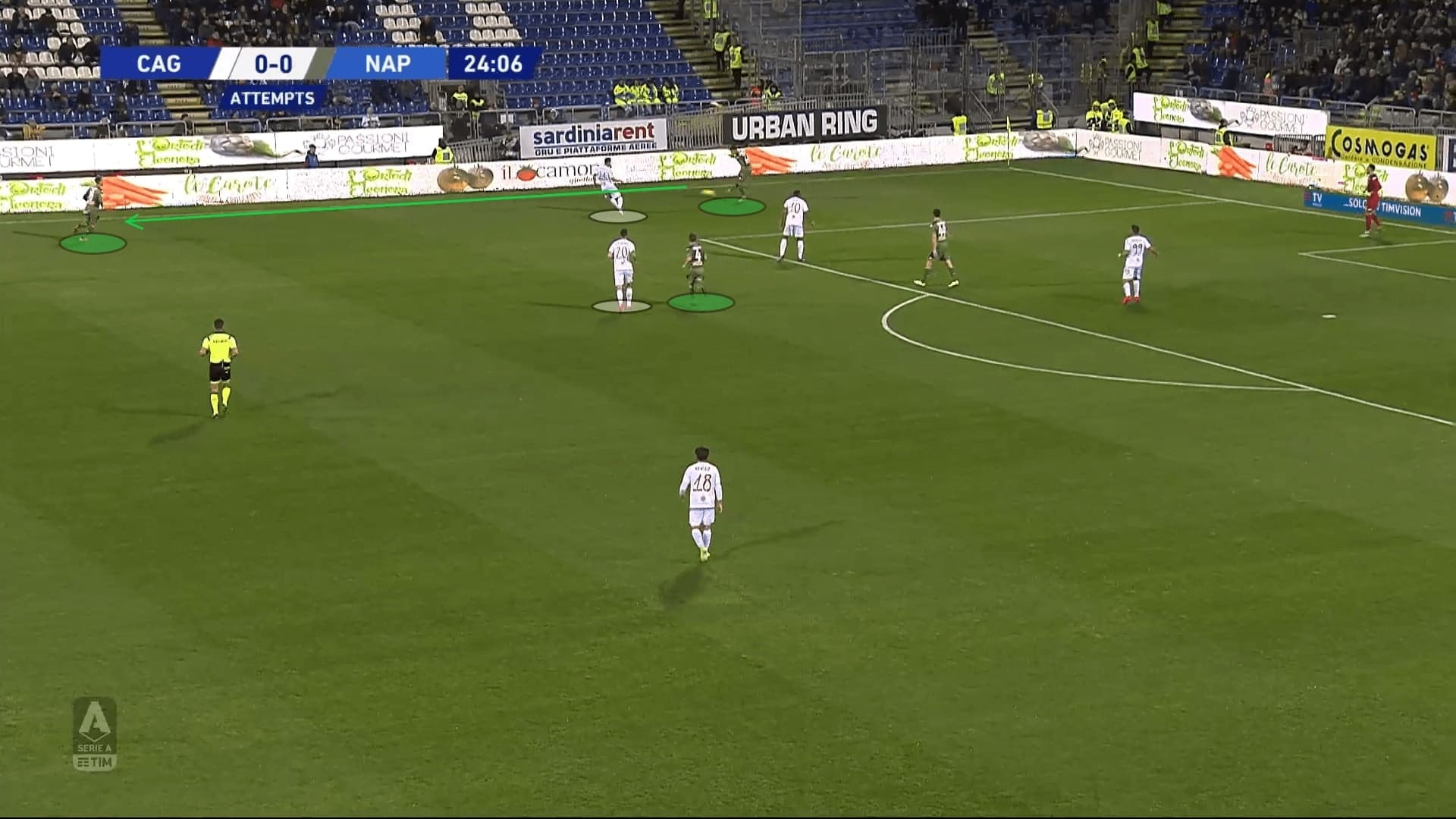
The presence of Ruiz also helps his team to fully utilize the numerical advantage in the build-up phase.
On occasions, despite enjoying an overload in the first offensive phase, workable passing triangles were not formed because of the flat positioning players.
When the sole pivot was covered, Napoli lacked progressive options.
At Napoli, Piotr Zieliński was kept high to support Insigne more often, so the progressive option was likely to be Ruiz.
We use the following image to illustrate the situation further.
Napoli had a 4 v 3 in the first phase, but the passing triangles could hardly form without Ruiz’s presence as Demme was covered by the striker.
Meanwhile, Di Lorenzo stayed on the same line with the centre-backs and he was not a progressive option.
The issue was solved by Ruiz’s movement, who came deep from a high positioning.
As connected by the green lines, passing triangles are formed while a passing lane is opened to the Spaniard.
The pass to Ruiz also enabled Napoli to beat the first line of press.
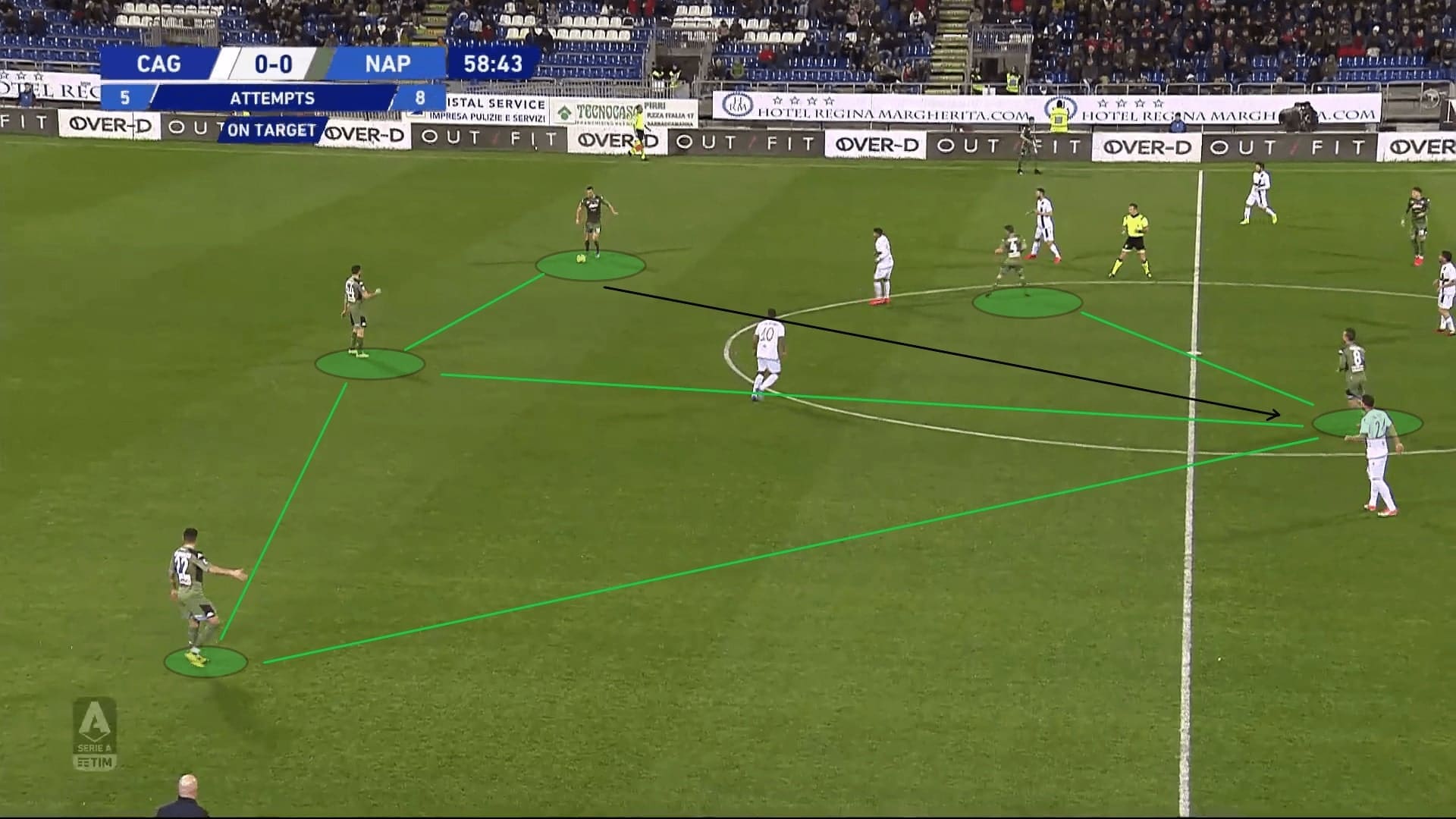
Ruiz’s computability in this tactic potentially allows him to fit into different systems, as a 3-2 or 2-3 build-up shape was standard in Europe nowadays.
For example, Pep Guardiola’s Manchester City used a 3-2 shape when Rodrigo Hernández was playing with İlkay Gündoğan.
Also, given his willingness to support the build-up phase, the team would have more variations to progress the ball upfield.
These dropping movements could be a decoy run to unmask a passing lane of the centre-forward if used appropriately.
Weaknesses exposed in the pivot role
As mentioned, Ruiz was moved to an advanced position after the arrival of Demme and Lobotka.
This was mainly because of his vulnerability defensively.
Playing as a sole pivot had to deal with the tremendous defensive workload, protecting the defenders.
It was also vital to choose the optimal positions during the defensive transitions.
When Napoli committed their players to join the attack, the pivot was likely isolated when facing the counterattacks.
Ruiz is quite uncomfortable in these situations.
Ruiz possesses the ability to scan the pitch while carrying the ball forward, but the situation was not the same before receiving the ball.
Sometimes, the 24-year-old relies too much on his multiple touches to escape from the opponents.
When the pressure was coming from his blindside, and it was quick, Ruiz could potentially lose the ball.
It was trouble when he was playing as the defensive midfielder, often dropped to receive a forward pass.
For example, when David Ospina played Ruiz the pass, Felipe Caicedo was also approaching Ruiz.
Ruiz did check his shoulders, but the direction of his vision was suboptimal.
Also, the closed body orientation also limited his received visual information.
Therefore, he failed to use his second touch to escape from Caicedo and lost the ball very close to his own goal.
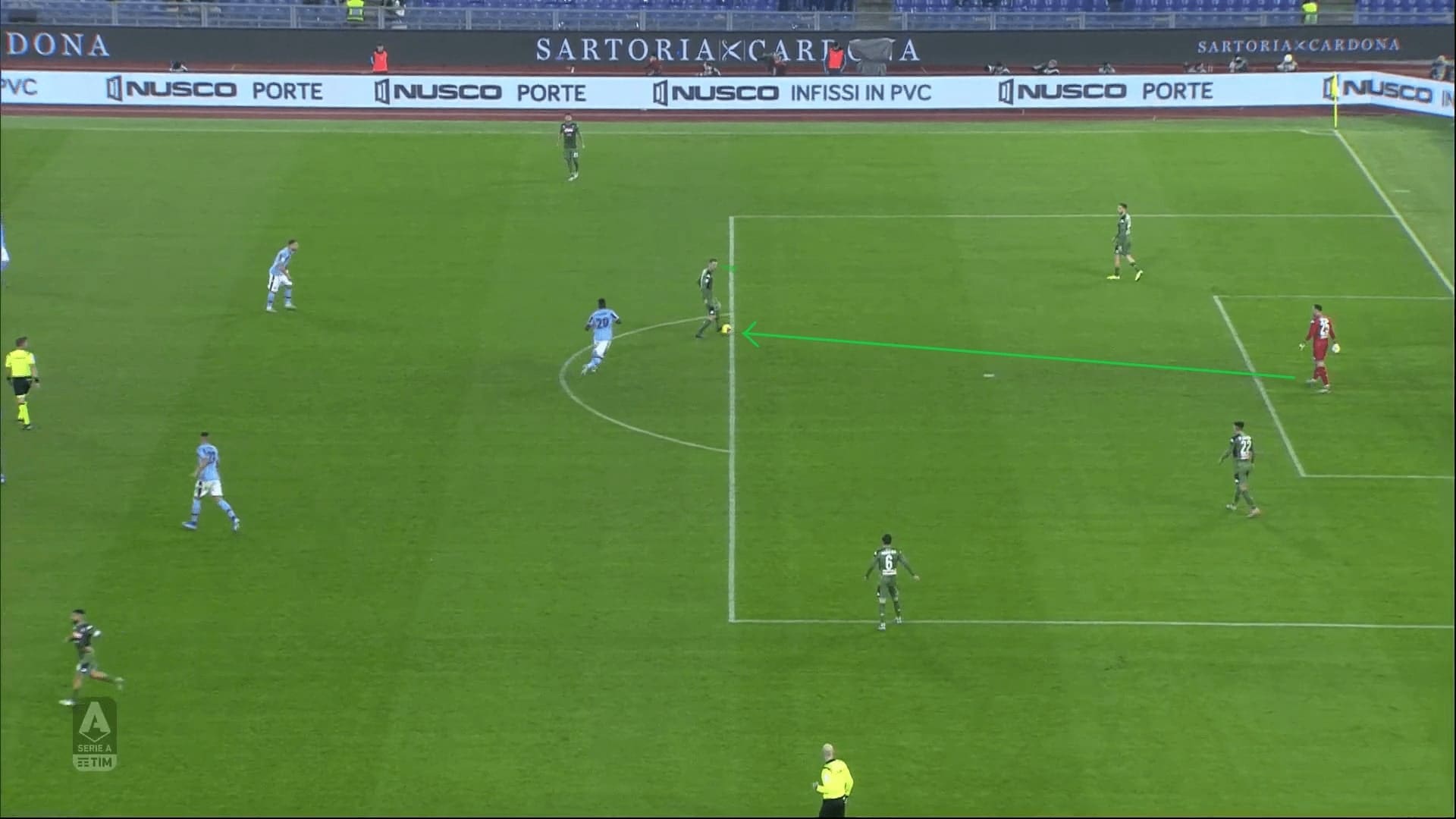
Ruiz was also vulnerable when he had to defend.
He did not possess the pace to match the counter-attacking players, so his initial positioning and angle of the challenges were important.
However, the ability of Ruiz to access a player was weak, and the body orientation was always suboptimal.
The opponent could quickly shake him off balance and dribble past Ruiz with some simple moves.
In the meantime, he also lacked the awareness to draw tactical fouls on the opponents, and large parts of the defensive transitions were covered by his teammates.
This was why Ruiz was not starting as a sole pivot anymore; he left the defence exposed.
Your team would never want Ruiz to defend in the 1 v 1 situations.
Even when defending in a block, sometimes his teammates would get mad at Ruiz because of his lack of willingness to step up.
The below image is an example.
When he had to approach the ball, Ruiz easily went off-balance because of Luis Alberto’s change of direction.
When the former Liverpool man sprinted, Ruiz was left behind and the defenders had to deal with it.
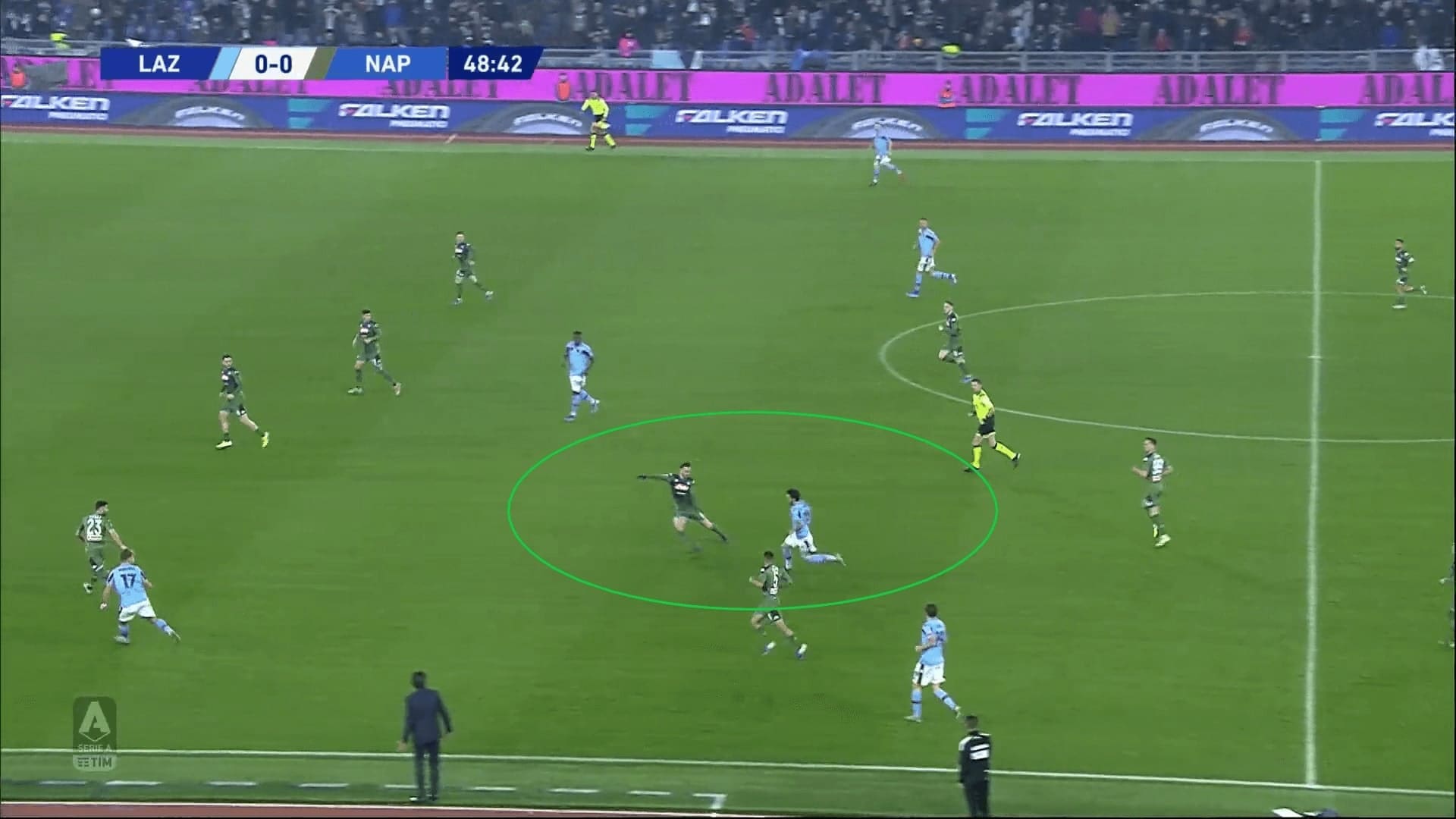
Potential moves
After analyzing Ruiz’s strengths and weaknesses, we are down to explain his potential next club, as he was a wanted man in the market.
According to the rumours, we identified three clubs which were possible to sign Ruiz as they needed a new, energetic member at the midfield.
These three clubs were suggested: City, Barcelona and Real Madrid.
Given Ruiz’s vulnerability as a sole pivot, he was more likely to play as an advanced midfielder at his new club.
These teams would want Ruiz as their original midfield option was ageing.
David Silva was leaving City as a free player this summer. If Phil Foden did not take his position, then Txiki Begiristain would have to find a new player in the market.
Ivan Rakitić was likely to leave Barcelona as well, and Barcelona could have tried to sign Ruiz to play alongside De Jong and Sergio Busquets.
Luka Modrić of Real Madrid was already 34 years old; clearly, he could not play every game for Madrid next season.
Toni Kroos might need a creative midfielder to play with him.
Intriguingly, Ruiz shared many similarities with the Modrić, and the budgets of Madrid make the transfer possible.
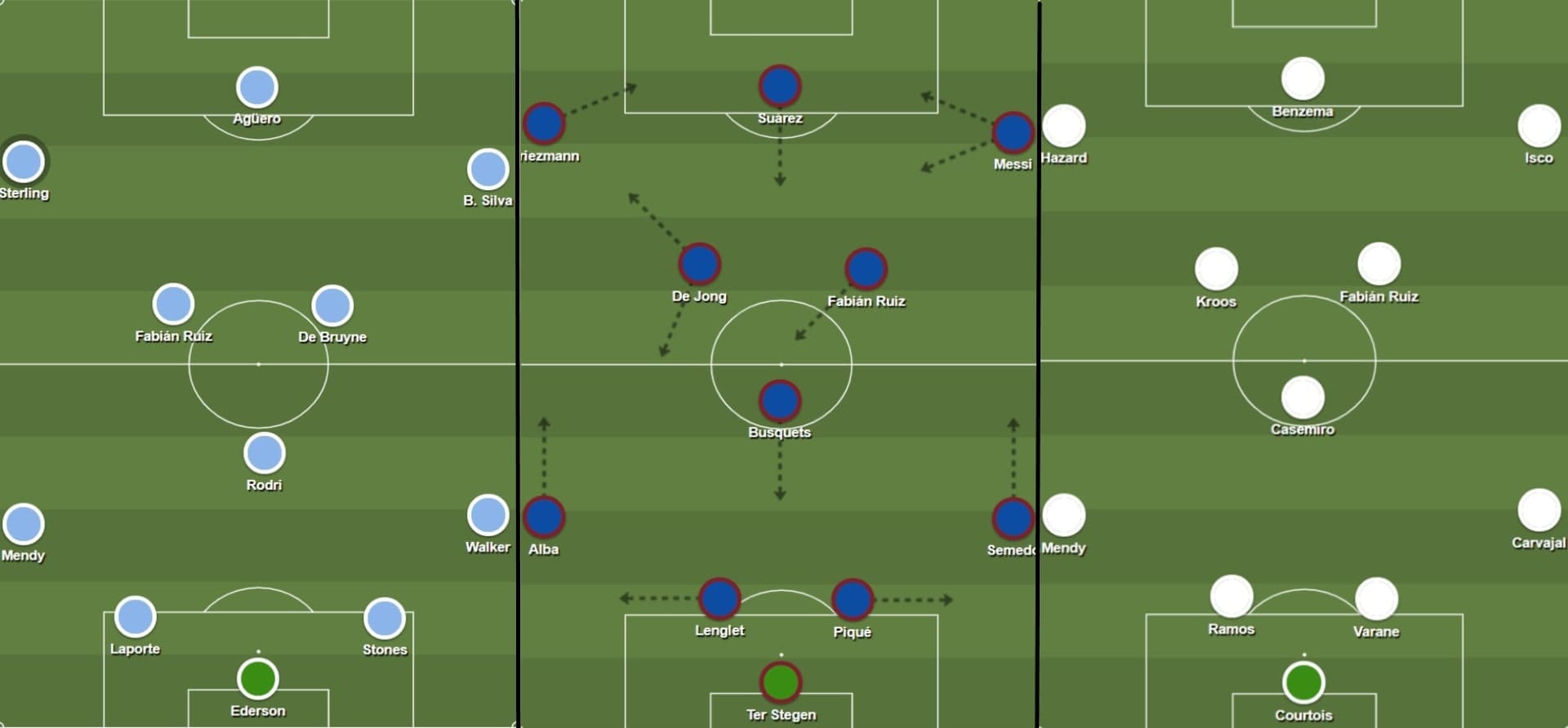
First, we compare the heat map of these players.
From 1 to 4 are Ruiz, Rakatić, Modrić and Silva.
In terms of the pitch coverage, Ruiz (1) had a very similar pattern to Rakatić (2); both nearly shaped a square at the central third.
Also, they were more active at the right half-spaces.
Ruiz had a wider coverage at both flanks as his tactical role at Napoli’s build-up as explained.
By contrast, Modrić (3) and Silva (4) focused mostly on their own half-spaces, as their ages hindered their ability to cover all areas on the pitch.
The signing of Ruiz might complement or even upgrade the team’s coverage on both half-spaces, easing the partner’s workload.
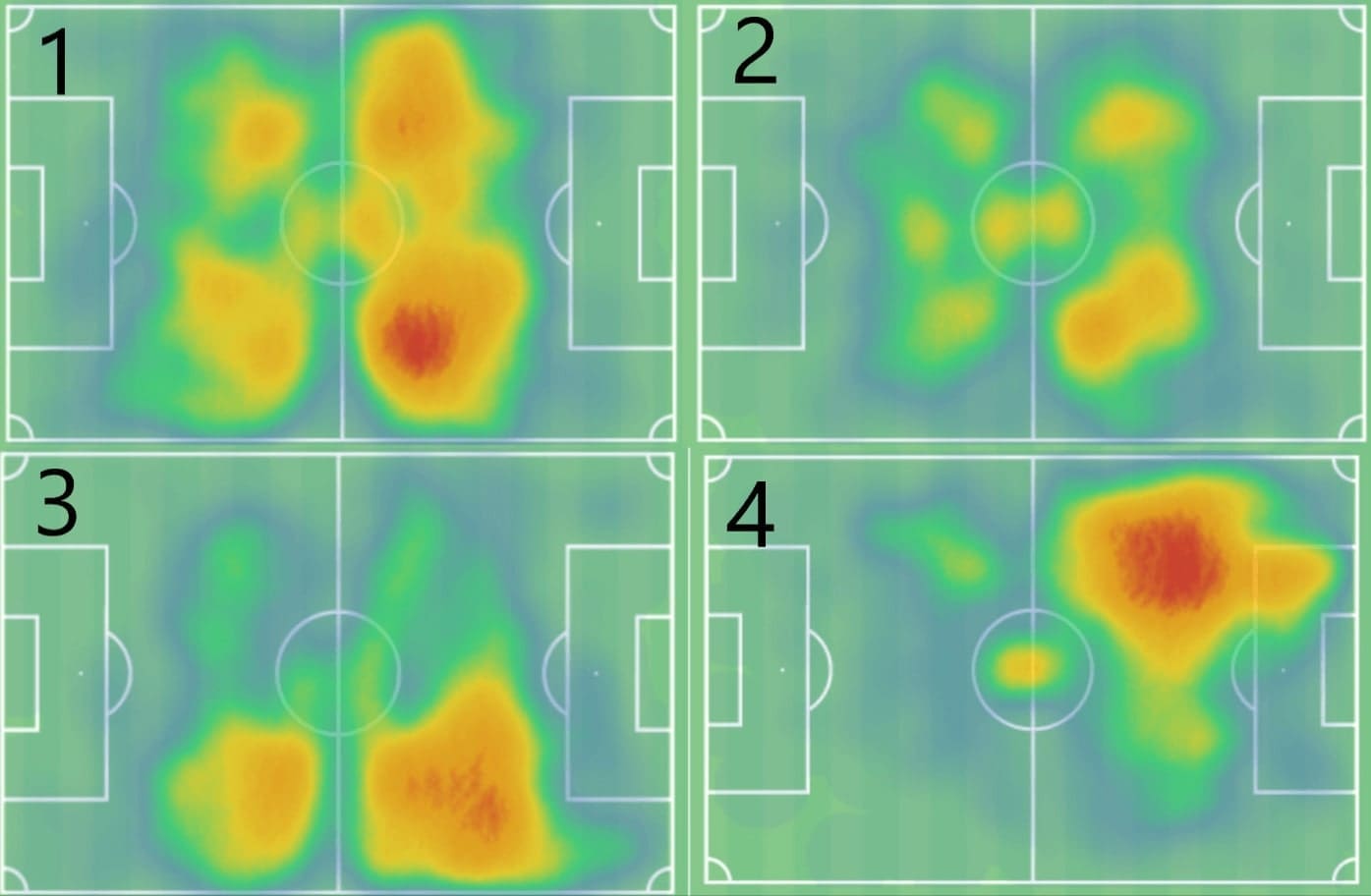
We also compared some other attributes of these players in the following table:
|
|
Ruiz | Rakitić | Modrić | Silva |
| Shots per game (xG) | 1.93 (0.07) | 0.9 (0.06) | 1.1 (0.08) | 1.39 (0.16) |
| Progressive runs per game | 2.44 | 0.84 | 1.63 | 1.75 |
| Dribbles (%) | 2.625 (69.04%) | 0.31 (41.67%) | 2.33 (54.29%) | 1.93 (59.26%) |
| Passing length per game (m) | 17.78 | 16.06 | 17.88 | 15.31 |
Ruiz had the highest average shot per game, but the xG only ranked 3rd.
This hinted that the Napoli man was more likely to shoot from a far position.
In the meantime, Ruiz was also the best when comparing the number of progressive runs and the quantity and quality of dribbles.
We could understand that the 24-year-old could provide more offensive events than merely passing.
Intriguingly, Ruiz also had a very similar average passing length to Modrić, his 17.78m was only slightly below the Croatian’s 17.88m.
He might be a good fit for Madrid.
So, how could Ruiz potentially play on his new team?
The last two examples of the analysis provide a brief idea.
Since teams were marking or covering the sole pivot, they always needed another progressive option.
With Ruiz, variations in the build-up phase increased.
The above sections explained two possibilities: Ruiz himself receiving the ball or unmasking a passing lane for a centre-forward.
The following image hinted another possibility, a third-man play to let the sole pivot to play his pass.
Ideally, a forward pass from the centre-back reached Ruiz behind the first line, while the Spanish midfielder tidily played the ball to Lobotka, who had a better body orientation and a wider angle of vision.
Imagine if the receiver was Busquets or Rodri, with these two exceptional midfielders, the whole offensive process would be smooth as they could execute their pass without pressure.
This also potentially helped the team to quickly access the opposition 3rd if forward runs behind the defenders were available.

Because of Ruiz’s positionings in the build-up phase, the full-backs could be released early.
So offensive full-backs like Benjamin Mendy, Ferland Mendy, Jordi Alba and Nélson Semedo were free to provide the width early.
All City, Barcelona, and Madrid used fake wingers or inside forwards so the team could place the full-back out wide and the winger at the half-spaces.
This could occupy more vertical zones of the pitch.
The combination would be even better if Ruiz polished his defensive ability, covering the full-backs if the ball was lost in the progression.
In the image below, you can see Ruiz instructing Di Lorenzo to push higher as he was dropping deep.
Such rotations might also be used to disguise the opponent to create dynamics in the attack.
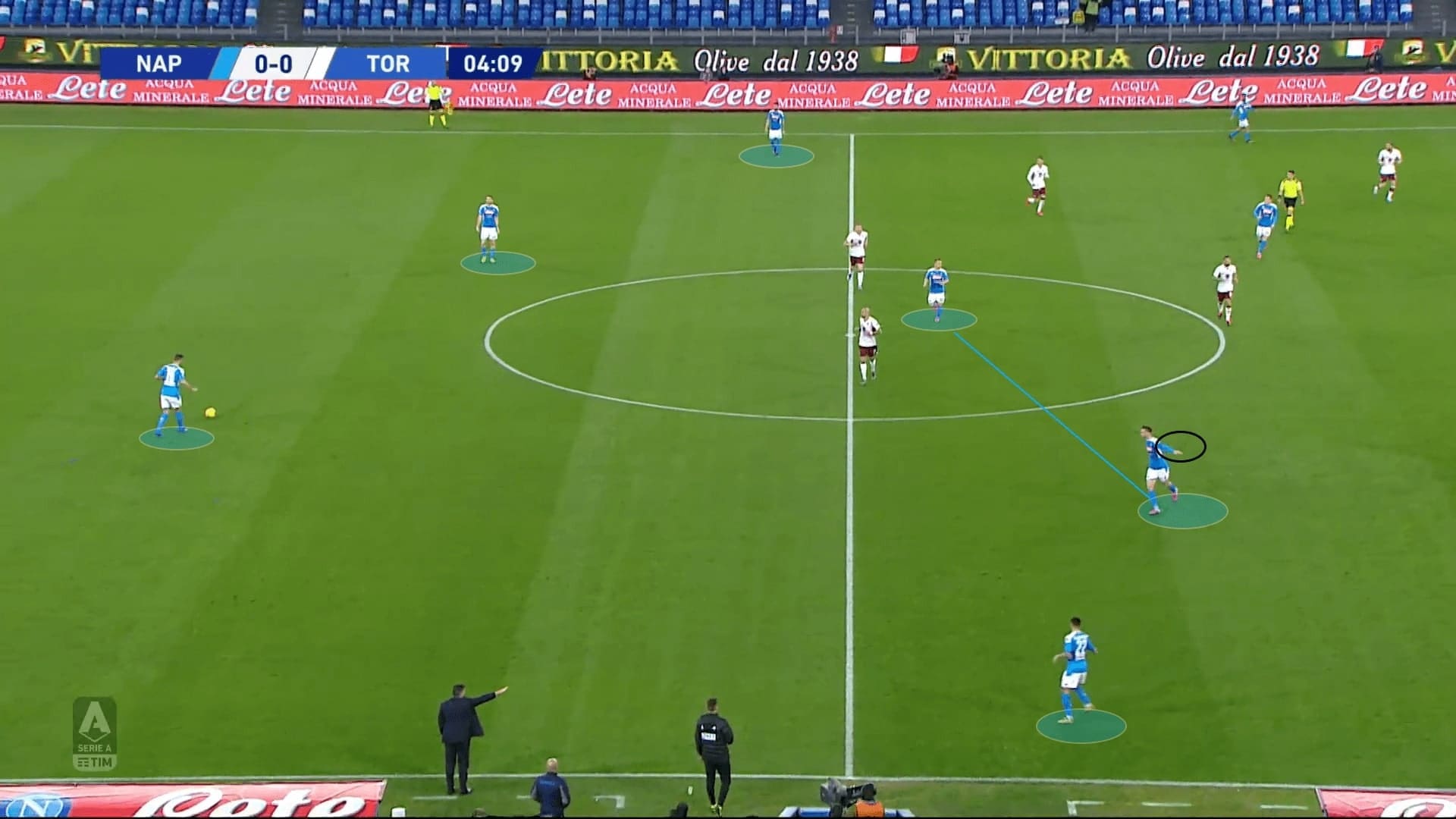
Conclusion
After playing in Spain and Italy, Fabián Ruiz gradually became one of the best midfielders in Europe.
He was technically gifted and had an offensive mindset, which was reflected by the types of his passes.
Ruiz was already one of the best midfielders in Serie A, and we would be excited to see if he could move to a bigger club in the coming years.





Comments